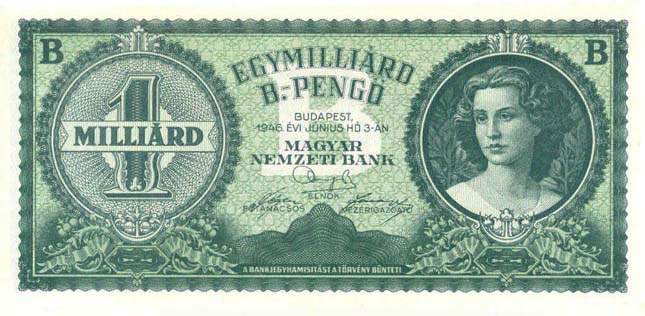When one bread cost 5.85 billion pengő – the Hungarian hyperinflation – photos

After WWII the official Hungarian currency, pengő lost its value in just a couple of months. Its highest denomination in mid-1946 was 100,000,000,000,000,000,000 (10 raised on the 20th power) pengő. Regarding hyperinflation, Hungary was world-leader until 2008, when Zimbabwean dollar’s crash exceeded even that.
Destruction, Red Army and compensation
When intellectual leaders of Hungary gathered together in Balatonszárszó to discuss the future of the country in 1943, they not only concluded that after the Second World War the whole world would be reshaped by the great powers and Hungary should remain neutral following its own interests, but they also agreed that – in contrast to WWI –
Hungary is able to finish the war with much less sacrifices and losses.
Unfortunately, they had it wrong.
Between 1944 August and 1945 April Hungary became the most important and brutal battlefield between the Soviet Red Army supported by Western aircraft and the German Wehrmacht. As a result, the whole country laid in ruins by the end of the war. In fact, 40 pc of the national wealth was destroyed or looted which was fifth as much as the total GDP of 1938. Furthermore, 40 pc of the rails were ravaged, most locomotives and carriages were taken away while all factories laid in ruins.

Thus, it is not surprising that the value of those days’ currency, the pengő, decreased swiftly. Hyperinflation was already well-known in Hungary by 1945 since the Treaty of Trianon, and political instability between 1919 and 1924 led to the major inflation of Hungarian korona. At its peak,
the rate of depreciation reached 98 pc per month.
The highest denomination: 1 billion-terra (10 raised on the 20th power) pengő
However, what happened between 1945 and 1946 was unprecedented not only in Hungary but also in the whole world.
Pengő was one of the most trusted currencies of Europe in the 1920s and the 1930s. Therefore, many Hungarians kept their savings in paper money put into their pillows. These sums evaporated already in 1944. Even though the new government of the country tried to follow a stricter fiscal policy, the victorious
Red Army issued paper money unchecked
which decreased its value day by day and confiscated everything it could as compensation.
Therefore, while one kilogram of bread cost 6 pengő in 1945 August, its price rose to 8 million by May next year and 5.85 billion one month later. Inflation peaked in July 1946 when pengő’s value decreased 41,900 billion in just one month. This meant that, on average,
prices doubled in every 15 hours.
As a result, money-based trade changed to a goods-based one, and people living in the cities went to the villages to exchange their coats, boots or porcelain for food. The highest denomination in mid-1946 was 100,000,000,000,000,000,000 (10 raised on the 20th power) pengő. Since this made taxation almost impossible, the government created a special currency, the tax pengő. Its value was adjusted each day, by radio announcement. However, it inflated in short, as well.

The solution of the incredible hyperinflation was the introducing of a new currency in August 1946, the forint (HUF) which Hungary uses even today. When the pengő was replaced by it, the total value of all Hungarian banknotes in circulation amounted to 1/1,000 of one US dollar. Quite shockingly, on 18 August 1946,
400,000,000,000,000,000,000,000,000,000 (4×10 on the 29th power) pengő became 1 forint.
Featured image: After forint was introduced shinplaster pengő was thrown to the streets giving much work to street-cleaners.
Photos: http://www.erdekesvilag.hu/a-legnagyobb-hiperinflaciok-a-vilagon/
Source:






thats actually so cool i cant believe that poor hungray thats actually so peak
thats actually so cool i cant believe that poor hungray thats actually so peak . mans boat is worth way more than a bit of bread they’ve been so shafted what dickheads